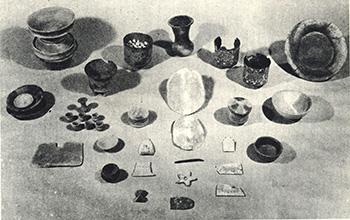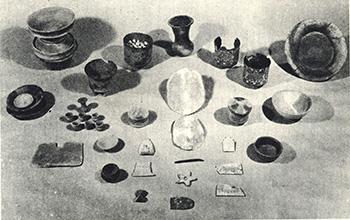
Burials and Society at Teotihuacan
Thousands of human burials have been excavated at Teotihuacan, most of which are in residential contexts. Individuals were buried under the floor of the house, usually in a simple grave with a few offerings. Many of these burials and their offerings have been published in reports and books in Mexico and the U.S., but they have never been entered into a single database for analysis. We are now entering and beginning to analyze this information, looking for any patterns that may indicate variations in wealth, status and ritual, as well as gender differences, both within individual apartment compounds and between compounds. We are not including the rich burials excavated inside pyramids and temples.
The people of ancient Teotihuacan buried their dead under the floors of their houses. Over the years, archaeologists have excavated hundreds of these burials, some with rich offerings and others with none. This project is creating a database of Teotihuacan burials and offerings in order to analyze patterns of wealth, status and gender at the ancient city. The project is organized and run by a team of undergraduate students, under the direction of Professor Michael E. Smith.
Project Details
This project has three interesting features:
First, we are addressing a crucial issue for the understanding of ancient Teotihuacan society. The study of housing and other materials suggests that the commoner population was highly prosperous, perhaps with a higher standard of living than people in other ancient Mesoamerican societies. Yet unlike other Mesoamerican cities, where differences between elites and commoners are clear and obvious to archaeologists, this distinction is blurred at Teotihuacan. What does this imply about society at there? Were there only a few elites? Or did elites have similar lifestyles to commoners? The numbers and types of offerings placed within human burials are clues to differences in wealth and status in an ancient society. We will be using the offerings associated with burials in residential contexts at Teotihuacan to broaden our understanding of wealth, status, identity, gender and ritual at the ancient city.
Second, this project shows the value of “legacy data” for continuing insights into ancient Teotihuacan. Most of these burials were excavated and analyzed long ago. But because we lack systematic comparisons of burials both within and between residential compounds, the burial data have not yet yielded their insights into this ancient society. We are using published data to produce new and important results about urban life at Teotihuacan.
Third is an, experiment in project management. While Smith is the official leader of the project, he is letting the student participants figure out basic questions and procedures. The students are working out the nature of the datafiles, the coding system, how to record data (and check its reliability), and how to begin analysis of the data. They are reading up on Teotihuacan burials and their implications. Smith is actively involved, but the basic procedures and activities are worked out through discussion with the student participants. Angela Huster and Marion Forest, postdoctoral scholars in Smith’s lab, also help to advise the students.
Research Team
- Michael E. Smith, Professor, ASU School of Human Evolution and Social Change
- Marion Forest, Postdoctoral Research Associate, ASU School of Human Evolution and Social Change
- Angela Huster, Postdoctoral Research Associate, ASU School of Human Evolution and Social Change
- Kirsten Holz, Undergraduate Student
- Noah Livingston, Undergraduate Student
- Thomas Lobato, Student, McClintock High School
- Katie McIlhennymiller, Undergraduate Student
- Sara Rodriguez, Undergraduate Student
- Madeline Stewart, Undergraduate Student
- Emily Edmonds, Undergraduate Student


